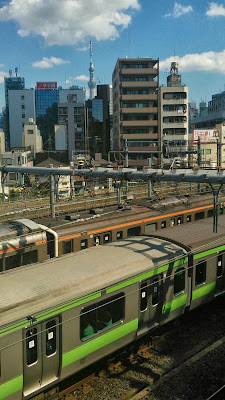On Tuesday morning, Ti and I participated in the official
tour of the Imperial Palace.
The tour is held two times a day on most days, but I had to submit an application about two or three weeks ago. Even with the reservation system, there were nearly 200 people on our tour, most of whom were retired Japanese people, but a few foreigners from other parts of Asia, Europe, Australia, and the U.S.
The Imperial Palace grounds are quite large, and are at the heart of Tokyo. The tour lasted for about an hour and a half, and was in Japanese, but there was also a small recorded English audio guide as well. The two tours were slightly different, with the English providing more historical context, and the Japanese providing more information on the architecture.
After providing our identification and reservation number, we started our tour in a large hall with a video introduction to the Imperial Palace, as well as information on what to expect (2 kilometers of walking, no food or drink, photos o.k., etc.). There was also a small shop with items emblazoned with the Imperial crest. Surprisingly (or not), there was very little security. No x-ray for bags, no metal detectors or pat downs, which are standard on the White House tour and at major U.S. monuments such as the Arch in St. Louis.
The first tour stop was Fujimi Yagura, which was part of the original Edo Castle. For some interesting information on the once gargantuan Edo Castle, of which only a small portion remains, click
here.
Fujimi Yagura, as now dwarfed by modern Tokyo.
The next stop was the
Imperial Household Agency. This agency controls all information related to the Japanese imperial family, and runs the Imperial Palace, imperial family collections, and imperial family tombs. Also of interest, this building, which dates from 1931, was where Emperor Hirohito lived in the years immediately following WWII, when the Imperial Palace was destroyed.
The new Imperial Palace, built in the late 1960s.
More of the Imperial Palace.
The famous
Nijubashi, or Double Bridge.
Another historic part of the grounds.
More of the Palace.
The large lotus pond, just beyond this is the rice field that the emperor ceremonially plants each year and the silk cultivation area where the empress participates in sericulture.
At the end of the tour, leaving through the Kikyomon.
Ti and I at the end of the tour.
Before each of us went of to our respective institutions for an afternoon of work, we had a lovely lunch near
Tokyo Station, and got a great view of the newly restored building.





















































